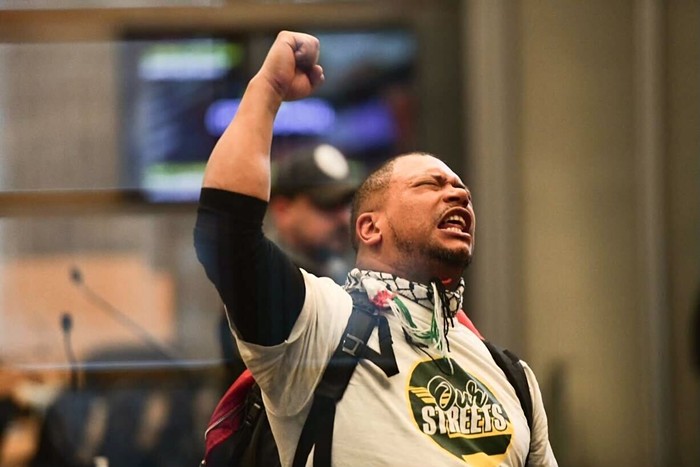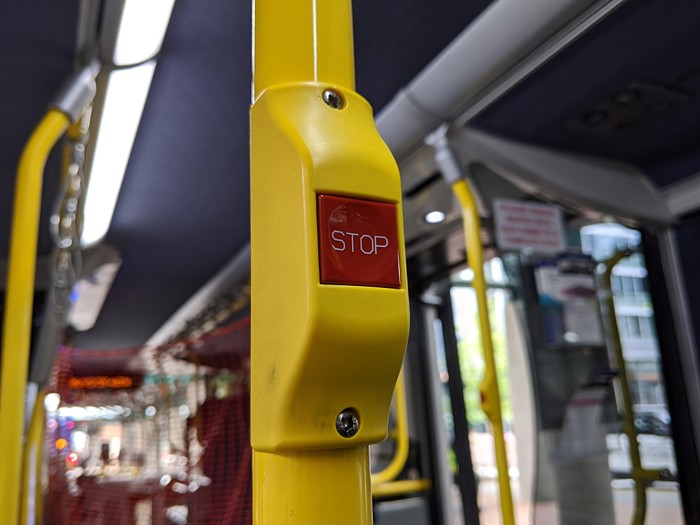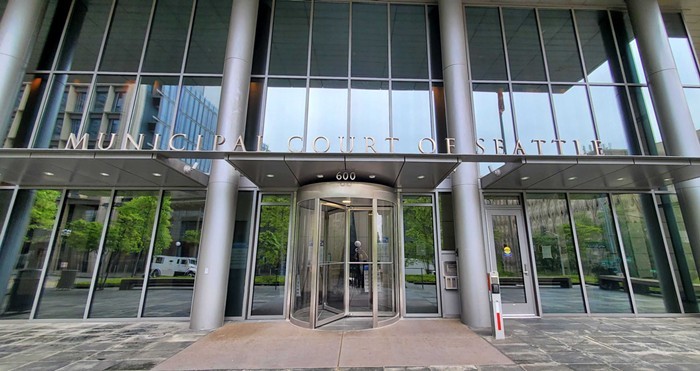The winning option Tuesday, March 13, wasn't even on the ballot. After Mayor Nickels's tunnel netted a paltry 30 percent of the vote (70 percent against) and the state's elevated highway option got barely 45 percent (55 against), the clear winner was the surface/transit option.
Earlier in the evening, starting at around 7:00 p.m., an increasingly rowdy crowd that would eventually grow to 300 jammed into the stifling Alki meeting room at the Edgewater Hotel anxiously awaiting the results of the two nonbinding up-or-down ballot measures—one on a larger elevated viaduct, one on a scaled-back, four-lane tunnel. After both freeways were defeated, the establishment figures on hand, like the Downtown Seattle Association's Kate Joncas, mainstream environmentalists like Aaron Ostrom from FutureWise, and Jessyn Farrell and Rob Johnson from the Transportation Choices Coalition (TCC), got busy re-tooling their raps to align themselves with the surface/transit option.
As Ostrom announced the results and the mayor entered the room followed by his entourage, one staffer began clapping loudly, but the room was slow to comply. Indeed, the mayor's show was put on hold while a TV reporter finished interviewing long-time surface/transit fan City Council Member Peter Steinbrueck in front of the mayor's podium—almost literally stealing Nickels's spotlight. Off to the side, Deputy Mayor Tim Ceis hugged surface/transit leader Cary Moon and told her quietly, "We'll be talking more soon."
The speeches began with TCC's Farrell who told the audience, "We have spent the last 50 years [building roads] and it has resulted in gridlock, it has resulted in climate change, and it has resulted in sprawl." Then Nickels, surprisingly for one of the most stubborn supporters of a tunnel freeway on the waterfront, echoed Farrell. "What [voters] said... is we do not want a freeway on our waterfront." Nickels alluded to conversations in recent days with County Executive Ron Sims (who was out of town, but supports the surface/transit option) and Gov. Christine Gregoire (who supports a rebuilt viaduct), and all but endorsed the surface/transit alternative.
Asked later, after Nickels scurried out dramatically, followed by a pack of cameras, what Nickels had meant by "not another freeway," Ceis was direct: "A big, ugly thing where cars go 50 to 60 miles per hour. The voters don't have to hit us on the head for us to get it." Then he gestured toward Moon with his glass of red wine. "There's your story. She's your storyline tonight." Moon, a dogged activist for the transit option for three years now, is a political novice, but her longstanding prediction that her option would emerge as the compromise solution was indeed the story of the night.
Over at the Spitfire on Fourth Avenue, the surface/transit supporters were still celebrating at 9:00 p.m. when Moon made her entrance after leaving the dwindling party at the Edgewater. She walked into the room to loud applause and said she hoped the mayor would "support the will of the voters and get onboard with the surface/transit plan" instead of considering other options that were beginning to circulate again, including a deep-bore waterfront tunnel. (The rejected tunnel was a cut-and-cover tunnel.) Steinbrueck, usually no fan of the mayor, had conciliatory words for the longtime tunnel supporter. "The mayor deserves to be praised for having stood up to the governor" against the rebuild, Steinbrueck said. "Now we need to rebuild consensus and partnership beyond the city." Steinbrueck, who recently announced he would not be seeking reelection to city council so that he could fight for the surface/transit option full-time, said that could include working with the mayor.
The viaduct battle has been going on for more than six years now—longer, if you count the studies in the 1980s that said the double-decker concrete freeway would be unsafe in an earthquake even before the 2001 Nisqually quake damaged it beyond easy repair. The city council and mayor have repeatedly stated their support for a tunnel to replace the viaduct, an option state officials seemed, at least initially, to support. However, once new cost estimates boosted the price of the city's preferred alternative to an unaffordable $3.6 billion-$5.5 billion, the state legislature asked Governor Gregoire to broker a compromise between Nickels (who still preferred the now-$4.6 billion tunnel) and House Speaker Frank Chopp (who insisted on a $2.8 billion new elevated viaduct). When attempts to broker a compromise failed, Gregoire decided she would punt the issue to the voters. Nickels, taking that as a sign that there was still room to maneuver, proffered a new proposal: a four-lane "tunnel lite" that would, he said, cost $1.2 billion less. Gregoire told Nickels the tunnel was off the table; nonetheless, he decided to push the measure forward, placing both the new elevated structure and the tunnel on the ballot in mid-March, a month earlier than Gregoire had previously requested.
Tuesday night's outcome was hardly surprising, given the overwhelming unpopularity of the tunnel and the slightly less overwhelming, but still decisive, unpopularity of the larger elevated rebuild. The new double-decker elevated viaduct would have averaged 71 percent larger than the current viaduct and cast a 50 percent larger shadow. And the "jaw-dropping" views of downtown would likely have been gone, obstructed by the higher guardrails required by modern safety standards. As for the four-lane tunnel: No one ever knew exactly how much it would cost, because it emerged so late in the discussion. Moreover, despite what the environmental groups that have endorsed the tunnel claimed, the tunnel would still be just another freeway with capacity for 130,000 cars, making it little better, from an environmental standpoint, than the elevated viaduct.
On Wednesday, after The Stranger went to press, the governor and mayor were expected to sit down again and attempt to hash out a solution. The speculation Tuesday night was that they would agree to begin work on the portions of the roadway south of King Street—the portions that are the same under any plan—and, possibly, to begin implementing the surface/transit option as a "stopgap" until a new plan can be devised. Simultaneously, Steinbrueck said he would introduce legislation freezing all city money for the viaduct in this year's budget (about $8 million) and allocating $500,000 to begin a joint city/county study of the surface/transit option, the council and mayor's official "backup" plan. But Tuesday night's clear victor, any way you look at it, was Cary Moon and her surface/transit option. ![]()
Watch our interview with Seattle City Council Member Peter Steinbrueck at Spitfire just after the results were reported.


















